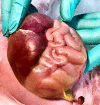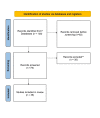Enhancing Omphalocele Care: Navigating Complications and Innovative Treatment Approaches
- PMID: 38021990
- PMCID: PMC10667945
- DOI: 10.7759/cureus.47638
Enhancing Omphalocele Care: Navigating Complications and Innovative Treatment Approaches
Abstract
Congenital abdominal wall abnormalities in infants present an interesting and difficult management problem for surgeons. Congenital malformations of the ventral abdominal wall can be diagnosed by their distinctive anatomical presentations. Among them, omphalocele, gastroschisis and umbilical cord hernias are the most frequently observed clinically detected abdominal wall anomalies. Omphalocele refers to the herniation of abdominal contents through a defect in the abdominal wall at the umbilicus with or without the presence of a sac. This article gives an insight into the embryology, risk factors, treatment, investigations and complications of omphalocele, a common congenital abdominal wall defect. There is minimal proof that environmental factors contribute to the development of omphalocele. However, there is a considerable amount of evidence which points to the importance of genetic or familial risk factors. Newborns and infants with prenatal diagnoses are the most frequently presenting patients with omphalocele to paediatric surgeons. This article describes the problems and the steps of management for handling each circumstance, as well as any further complications. Omphalocele and gastroschisis are frequently described together in many research papers. However, it's crucial to consider that they are two different conditions which vary in anatomy, pathology and associated conditions which account for the difference in their treatments and noticeably varied outcomes. Additionally, there is evidence that each has a different set of factors associated with risk for occurrence. There are no known etiologic causes that cause these abnormalities to develop. The size of the baby, the extent of the lesion, and any other disorders all affect how individuals with these congenital abdominal wall anomalies are treated.
Keywords: abdominal wall defect; complications; embryology; gastroschisis; giant omphalocele; omphalocele; risk factors; treatment.
Copyright © 2023, Malhotra et al.
Conflict of interest statement
The authors have declared that no competing interests exist.
Figures



Similar articles
-
Omphalocele and Associated Anomalies: Exploring Pulmonary Development and Genetic Correlations-A Literature Review.Diagnostics (Basel). 2025 Mar 10;15(6):675. doi: 10.3390/diagnostics15060675. Diagnostics (Basel). 2025. PMID: 40150018 Free PMC article. Review.
-
Abdominal Wall Defects.Neoreviews. 2020 Jun;21(6):e383-e391. doi: 10.1542/neo.21-6-e383. Neoreviews. 2020. PMID: 32482700 Review.
-
Abdominal wall defects.Transl Pediatr. 2021 May;10(5):1461-1469. doi: 10.21037/tp-20-94. Transl Pediatr. 2021. PMID: 34189105 Free PMC article. Review.
-
[Clinical analysis of congenital abdominal wall defects--omphalocele and gastroschisis].Med Pregl. 2006 Jul-Aug;59(7-8):347-55. doi: 10.2298/mpns0608347t. Med Pregl. 2006. PMID: 17140035 Serbian.
-
Fetal omphalocele and gastroschisis: a review of 24 cases.AJR Am J Roentgenol. 1986 Nov;147(5):1047-51. doi: 10.2214/ajr.147.5.1047. AJR Am J Roentgenol. 1986. PMID: 2945411
Cited by
-
Omphalocele and Associated Anomalies: Exploring Pulmonary Development and Genetic Correlations-A Literature Review.Diagnostics (Basel). 2025 Mar 10;15(6):675. doi: 10.3390/diagnostics15060675. Diagnostics (Basel). 2025. PMID: 40150018 Free PMC article. Review.
References
-
- Prenatal diagnosis and management of omphalocele. Verla MA, Style CC, Olutoye OO. Semin Pediatr Surg. 2019;28:84–88. - PubMed
-
- Clinical risk factors for gastroschisis and omphalocele in humans: a review of the literature. Frolov P, Alali J, Klein MD. Pediatr Surg Int. 2010;26:1135–1148. - PubMed
-
- Gastroschisis and omphalocele. Ledbetter DJ. Surg Clin North Am. 2006;86:249-60, vii. - PubMed
-
- Gastroschisis: a state-of-the-art review. Bhat V, Moront M, Bhandari V. https://doi.org/10.3390/children7120302. Children (Basel) 2020;7:302. - PMC - PubMed
Publication types
LinkOut - more resources
Full Text Sources
